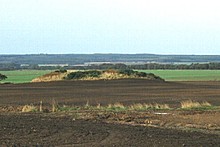|
|
|
|
Seamer BeaconRound Barrow(s)
|
||||||||||||||||||||||||
|
|
|
Images (click to view fullsize) |
|





|
Fieldnotes |
|
|
24/09/2017 – I liked this one. Not really much to see but the walk up from Scarborough is nice and the top very green with a good clump of trees hiding the beacon. Worth going for a little leg stretch. Nice views and the access is fine. If you are in the area it’s worth popping by the Rotunda Museum near the sea front. Nice display of objects from Star Carr and Bronze age Gristhorpe Man with his fantastic tree trunk burial. |
 Posted by thelonious
Posted by thelonious29th September 2017ce |
|
Seamer beacon is located just off the A170 on the edge of Scarborough. To access the site, turn off the A170 at Irton Mount and drive up to the wireless station and park in the car park there. The beacon is an obvious feature and easy to access. The top of the beacon was once a folly which has now fallen into disrepair. The folly was constructed from large and generally unworked stone. The possible source of this stone could have been the stone circle and cist reported by Frank Elgee " Forty five feet from outside of the barrow, a stone circle surrounded the cist." There are a number of barrows in this area including the lovely named Hagworm Hill. The beacon itself has an excellent aspect and is perfectly placed to relay signals from Scarborough Castle to the hinterlands of the vale of Pickering and beyond. There was once a Roman signal station (not to mention Bronze and Iron age settlements) situated on the Scarborough Castle site and given the local barrows and earthworks I think it it safe to assume that this site has been utilised since the Bronze Age. The position of this site has not been lost on telecommunications folk, there is a large array of dishes and masts situated close to the site, continuity of use or what? The OS map has an earthwork marked between the beacon and Hagworm Hill, Brigantesnation and I searched extensively and found no trace of this earthwork. |
 Posted by fitzcoraldo
Posted by fitzcoraldo21st October 2002ce |
Miscellaneous |
|
|
Seamer Beacon can be seen from a fair distance from the south especially from the Starr Carr area about 5 miles away. Unfortunately Fitz failed to mention that at least some of the hill forms part of GCHQ Scarborough - I don't know where he parked but the entrance I found was less than welcoming ;-) A sign did state however that there was a 'permissive' path up the hill, it's actually a public footpath so yah boo sucks to GCHQ. The stone folly will be Baron Albert's Tower which was built in the 19th century on the top of a levelled barrow. Hagworm Hill is about 44 metres in diameter and 3 metres high with a silted-up 2 metre wide ditch. When it was excavated in the 19th century several burials were found in stone lined cists, although I don't know whether the stone was left in the barrow or transported to a local museum. A excavation in the 1970s found more burials, sherds and flint, it also established that the barrow had an outer kerb of stones and a smaller internal stone ring. Could it be that these stones were Elgee's stone circle? |
 Posted by Chris Collyer
Posted by Chris Collyer18th July 2003ce Edited 21st July 2003ce |
| Hag-worm is Yorkshire for an Adder (Pelias berus) |
 Posted by fitzcoraldo
Posted by fitzcoraldo19th November 2002ce |
|
"In the central cist of a barrow near the Beacon on Seamer Moor, the floor of which was 7 1/2 feet below the top of the mound, Lord Londesborough discovered a vessel containing ashes and teeth. Nine feet from the central grave was a large stone embedded in the natural soil, at one corner of which lay a vessel of type 2 . It also held the ashes of an animal or human being, and close to it were calcined human bones. Forty five feet from outside of the barrow, a stone circle surrounded the cist." Early Man In N.E. Yorkshire Frank Elgee John Bellows Pub. 1930 |
 Posted by fitzcoraldo
Posted by fitzcoraldo21st October 2002ce |

